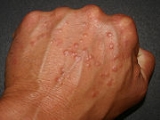
Granuloma annulare
Encyclopedia
Granuloma annulare is a chronic skin
disease consisting of a rash with reddish bumps arranged in a circle or ring. Granuloma annulare is different from warts, and cryotherapy
treatment will not work. It most often affects children, young and older adults and it is slightly more common in females (60/40 ratio).
Its cause is unknown.
s below the skin. Occasionally, multiple rings may be found. Rarely, granuloma annulare may appear as a firm nodule under the skin of the arms or legs.
or methylprednisolone
. Subdermally injected corticosteroids such as triamcinolone
have also been effective in reducing the size and spread of granuloma annulare.
in 1902.
Skin
-Dermis:The dermis is the layer of skin beneath the epidermis that consists of connective tissue and cushions the body from stress and strain. The dermis is tightly connected to the epidermis by a basement membrane. It also harbors many Mechanoreceptors that provide the sense of touch and heat...
disease consisting of a rash with reddish bumps arranged in a circle or ring. Granuloma annulare is different from warts, and cryotherapy
Cryotherapy
Cryotherapy is the local or general use of low temperatures in medical therapy or the removal of heat from a body part. The term "cryotherapy" comes from the Greek cryo meaning cold and the word therapy meaning cure...
treatment will not work. It most often affects children, young and older adults and it is slightly more common in females (60/40 ratio).
Types
Granuloma annulare may be divided into the following types:- Localized granuloma annulareLocalized granuloma annulareLocalized granuloma annulare is a skin condition of unknown cause, tending to affect children and young to middle-aged adults, usually appearing on the lateral or dorsal surfaces of the fingers or hands, elbows, dorsal feet, and ankles.- References :...
- Generalized granuloma annulareGeneralized granuloma annulareGeneralized granuloma annulare is a skin condition of unknown cause, tending to affect women in the fifth and sixth decades, presenting as a diffuse but symmetrical, papular or annular eruption of more than ten skin lesions, and often hundreds....
- Patch-type granuloma annulare Patch-type granuloma annularePatch-type granuloma annulare is a skin condition of unknown cause, more commonly affecting women between 30 and 70 years of age, characterized by flat or slightly palpable erythematous or red-brown skin lesions....
- Subcutaneous granuloma annulareSubcutaneous granuloma annulareSubcutaneous granuloma annulare is a skin condition of unknown cause, most commonly affecting children, with boys affected twice as commonly as girls, characterized by skin lesions most often on the lower legs.- References :...
- Perforating granuloma annularePerforating granuloma annularePerforating granuloma annulare is a skin condition of unknown cause, usually appearing on the dorsal hands, presenting as papules with a central keratotic core.- References :...
- Granuloma annulare in HIV diseaseGranuloma annulare in HIV diseaseGranuloma annulare in HIV disease is a skin condition characterized typically by papular and generalized skin lesions.- References :...
Causes
The condition is usually seen in otherwise healthy people. Occasionally, it may be associated with diabetes or thyroid disease. It has also been associated with auto-immune diseases like SLE.Its cause is unknown.
Presentation
Aside from the visible rash, granuloma annulare is usually asymptomatic. Sometimes the rash may burn or itch. Patients usually notice a ring of small, firm bumps (papules) over the backs of the forearms, hands or feet, often centered around joints or knuckles. The bumps are caused by the clustering of T cellT cell
T cells or T lymphocytes belong to a group of white blood cells known as lymphocytes, and play a central role in cell-mediated immunity. They can be distinguished from other lymphocytes, such as B cells and natural killer cells , by the presence of a T cell receptor on the cell surface. They are...
s below the skin. Occasionally, multiple rings may be found. Rarely, granuloma annulare may appear as a firm nodule under the skin of the arms or legs.
Prognosis and treatment
Because granuloma annulare is usually asymptomatic, treatment may not be necessary except for cosmetic reasons. Most lesions of granuloma annulare disappear in pre-pubertal patients with no treatment within two years while older patients (50+) have rings for upwards of 20 years. The appearance of new rings years later is not uncommon. In some cases, successful treatment has involved topical and oral corticosteroids such as clobetasol propionateClobetasol propionate
Clobetasol propionate is a corticosteroid used to treat various skin disorders including eczema and psoriasis. It is also highly effective for contact dermatitis caused by exposure to poison ivy/oak. Clobetasol belongs to US Class I of the corticosteroids, making it one of the most potent...
or methylprednisolone
Methylprednisolone
Methylprednisolone is a synthetic glucocorticoid or corticosteroid drug. It is marketed in the USA and Canada under the brand names Medrol and Solu-Medrol. It is also available as a generic drug....
. Subdermally injected corticosteroids such as triamcinolone
Triamcinolone
Triamcinolone is a long-acting synthetic corticosteroid given orally, by injection, inhalation, or as a topical ointment or cream....
have also been effective in reducing the size and spread of granuloma annulare.
History
The disease was first described in 1895 by Thomas Colcott Fox and it was named granuloma annulare by Henry Radcliffe CrockerHenry Radcliffe Crocker
Henry Radcliffe Crocker, MD, FRCP was an English dermatologist. Originally from Hove in Sussex, Crocker started his working life as an apprentice to a general practitioner, before going to London to attend the University College Hospital medical school...
in 1902.

